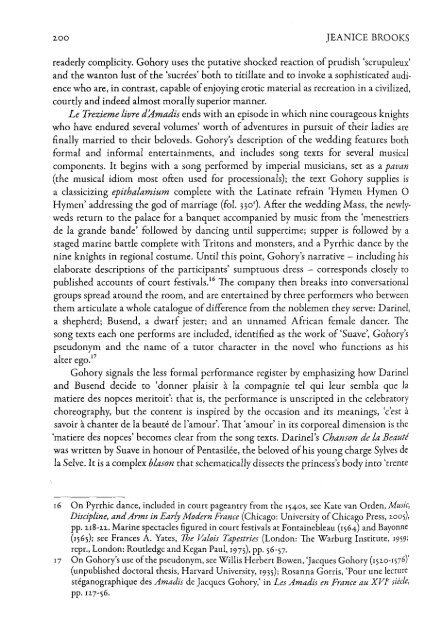obscenites renaissantes - ePrints Soton - University of Southampton
obscenites renaissantes - ePrints Soton - University of Southampton
obscenites renaissantes - ePrints Soton - University of Southampton
You also want an ePaper? Increase the reach of your titles
YUMPU automatically turns print PDFs into web optimized ePapers that Google loves.
zoo<br />
JEANICE BROOKS<br />
readerly complicity. Gohory uses the putative shocked reaction <strong>of</strong> prudish 'scrupuleux'<br />
and the vyanton lust <strong>of</strong> the 'sucrees' both to titillate and to invoke a sophisticated audience<br />
who are, in contrast, capable <strong>of</strong> enjoying erotic material as recreation in a civilized,<br />
courtly and indeed almost morally superior manner.<br />
Le Trezieme livre d'Amadis ends with an episode in which nine courageous knights<br />
who have endured several volumes' worth <strong>of</strong> adventures in pursuit <strong>of</strong> their ladies are<br />
finally married to their beloveds. Gohory's description <strong>of</strong> the wedding features both<br />
formal and informal entertainments, and includes song texts for several musical<br />
components. It begins with a song performed by imperial musicians, set as a pavan<br />
(the musical idiom most <strong>of</strong>ten used for processionals); the text Gohory supplies is<br />
a classicizing epithalamium complete with the Latinate refrain 'Hymen Hymen 0<br />
Hymen' addressing the god <strong>of</strong> marriage (fol. 330'). After the wedding Mass, the newlyweds<br />
return to the palace for a banquet accompanied by music from the 'menestriers<br />
de la grande bande' followed by dancing until suppertime; supper is followed by a<br />
staged marine battle complete with Tritons and monsters, and a Pyrrhic dance by the<br />
nine knights in regional costume. Until this point, Gohory's narrative - including his<br />
elaborate descriptions <strong>of</strong> the participants' sumptuous dress - corresponds closely to<br />
published accounts <strong>of</strong> court festivals.The company then breaks into conversational<br />
groups spread around the room, and are entertained by three performers who between<br />
them articulate a whole catalogue <strong>of</strong> difference from the noblemen they serve: Darinel,<br />
a shepherd; Busend, a dwarf jester; and an unnamed African female dancer. The<br />
song texts each one performs are included, identified as the work <strong>of</strong> 'Suave', Gohory's<br />
pseudonym and the name <strong>of</strong> a tutor character in the novel who functions as his<br />
alter ego.^^<br />
Gohory signals the less formal performance register by emphasizing how Darinel<br />
and Busend decide to 'donner plaisir a la compagnie tel qui leur sembla que la<br />
matiere des nopces meritoit': that is, the performance is unscripted in the celebratory<br />
choreography, but the content is inspired by the occasion and its meanings, 'c'est a<br />
savoir a chanter de la beaute de I'amour'. That 'amour' in its corporeal dimension is the<br />
'matiere des nopces' becomes clear from the song texts. Darinel's Chanson de la Beaute<br />
was written by Suave in honour <strong>of</strong> Pentasilee, the beloved <strong>of</strong> his young charge Sylves de<br />
la Selve. It is a complex blason that schematically dissects the princess's body into 'trente<br />
16 On Pyrrhic dance, included in court pageantry from the 1540s, see Kate van Orden, Music,<br />
Discipline, and Arms in Early Modern France (Chicago: <strong>University</strong> <strong>of</strong> Chicago Press, 1005),<br />
pp. zi8-ii. Marine spectacles figured in court festivals at Fontainebleau (1564) and Bayonne<br />
(1565); see Frances A. Yates, The Valois Tapestries (London: The Warburg Institute, 1959;<br />
repr., London: Routiedge and Kegan Paul, 1975), pp. 56-57.<br />
17 On Gohory's use <strong>of</strong> the pseudonym, see Willis Herbert Bowen, 'Jacques Gohory (1510-1576)'<br />
(unpublished doctoral thesis. Harvard <strong>University</strong>, 1935); Rosanna Gorris, 'Pour une lecture<br />
steganographique des Amadis de Jacques Gohory,' in Les Amadis en France au XVI' Steele,<br />
pp. 117-56.
















